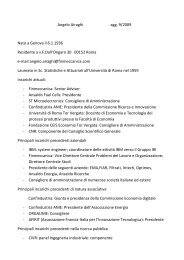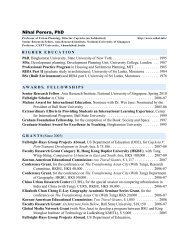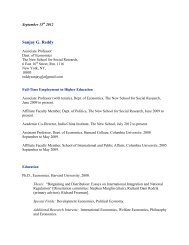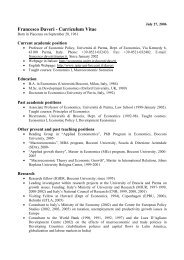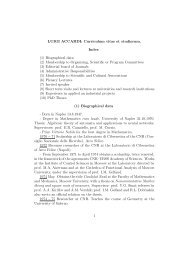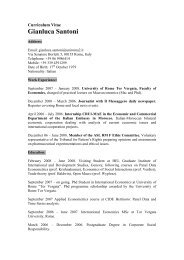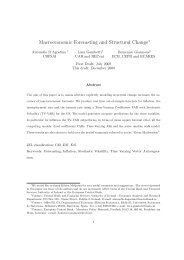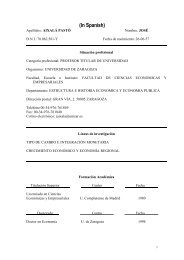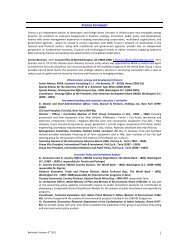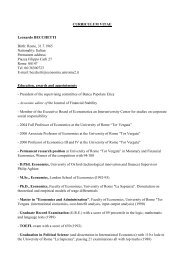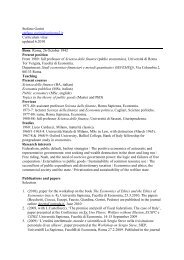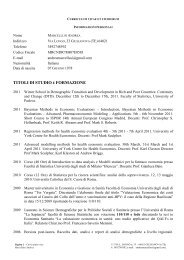Stochastic Extended Path - CEIS
Stochastic Extended Path - CEIS
Stochastic Extended Path - CEIS
Create successful ePaper yourself
Turn your PDF publications into a flip-book with our unique Google optimized e-Paper software.
STOCHASTIC EXTENDED PATH 5of sparse grids.We use this Gaussian quadrature to approximate the expectation in the Euler equations (1b).Suppose that S = 1, for a given order of approximation p and associated Gaussian quadratureweights and nodes {(ω i , x i ); i = 1, . . . , p}, we can approximate the expectations at time t bysolving p perfect foresight models with shocks in t + 1 defined by the Gaussian quadraturenodes and averaging the p simulated paths for the endogenous variables with weights givenby the Gaussian quadrature weights. More generally, if S > 1 we define paths for the futureshocks. The figure 7 illustrates the paths of future innovations to be considered if S = p = 3.The most likely sequence of innovation is the central path where the innovations remain nullin the future. Again the number of paths explode exponentially when S grows. If we have onescalar innovation in the model, and if we use an order p Gaussian approximation, the numberof paths is p S . If we have more than one innovation (n s > 1), the total number of paths is p Sn s.We approximate the expectations at time t by solving p Sn sperfect foresight models with thesesequences of future innovations and averaging the p Sn ssimulated paths for the endogenousvariables with the probability of each path. Clearly, this approach suffers from the well knownCurse of Dimensionality. Note however that the proposed computation of the expectation is anembarrassingly parallel problem 1 , meaning that it is quite simple to distribute the evaluationof the expected terms on multiple threads.The stochastic extended path approach is more formally described in algorithm 2. In this casewe assume that the innovations are normally distributed. For another parametric assumptionabout the distribution of the innovations we may have to adapt the Gaussian quadrature rule.Note that an alternative implementation, which can be done in a Dynare mod file (see Adjemianet al. (2011)), would be to build an extended model consisting in the replication of theoriginal model for different paths of the future innovations (treated as parameters) and a setof equations for averaging the replicated endogenous variables. With this extended model, theSEP approach can be implemented using algorithm 1 instead of algorithm 2.1 It is true that parallelization does not solve the Curse of Dimensionality issue, but in practice it can considerably reducethe burden cost of evaluating these integrals.
6 S. ADJEMIAN AND M. JUILLARDAlgorithm 2 <strong>Stochastic</strong> extended path algorithm1. H ← Set the deterministic horizon of the perfect foresight models.2. S ← Set the stochastic horizon of the SEP solver.3. p ← Set the order of approximation of the (Hermite) Gaussian quadrature.4. {(ɛ i , ω i ); i = 1, . . . , p} ← Compute the weights and nodes of the Gaussian quadrature.5. {(ε 1,j . . . , ε S,j , ϖ j ); j = 1, . . . , p Sn s} ← Enumerate all the future paths for the innovations.6. {(ε 1,j . . . , ε S,j , ϖ ⋆ j ); j = 1, . . . , pSn s} ← Normalize the weights so that ∑ pSnsj=1 ϖ⋆ j= 1.7. {(u 1,j , . . . , u S,j , ϖ ⋆ j ); j = 1, . . . , pSn s} ← Normalize the shocks: u s,j = Σ − 2 1 ε s,j / √ 2.8. (s 1 , x 1 ) ← Choose an initial condition for the state variables.9. for t = 1 to T do10. y = 0 ← Initialize the time t endogenous non predetermined variables.11. x + = 0 ← Initialize the time t + 1 endogenous state variables.12. for j = 1 to p Sn sdo13. (y j , x +,j ) ← Solve a PF model with y t+H = y ⋆ and future shocks u 1,j , . . . , u S,j .14. (y, x + ) = (y, x + ) + ϖ ⋆ j× (y j , x +,j ) ← Update the endogenous variables.15. end for16. (y t , x t+1 ) = (y, x + ) ← Set the non predetermined and state variables.17. u ← Draw from a multivariate Gaussian distribution with variance Σ.18. s t+1 ← Q(s t , u)19. end for3. IllustrationWe start with a simple nonlinear asset pricing model, proposed by Burnside (1998), for whichthere exist a closed-form solution. It is an endowment economy where a single perishableconsumption good produced by a single tree. A representative household can hold equity totransfer consumption from one period to the next. The household’s inter temporal utility isgiven by{ ∞∑E t β t−τ cθ t+τθτ=0where c t represents consumption in period t.The budget constraint is given by}with θ ∈ (−∞, 0) ∪ (0, 1]p t e t+1 + c t = (p t + d t ) e twhere p t is the price of one unit of equity. e t indicates the number of units of equity detainedby the household at the beginning of period t and d t is the dividend paid for one unit of equity.Dividends d t are growing at rate x t :d t = exp (x t ) d t−1x t = (1 − ρ) ¯x + ρx t−1 + ɛ t
STOCHASTIC EXTENDED PATH 7The dynamics of this economy can be summarized byy t = βE t {exp (θx t+1 ) (1 + y t+1 )}x t = (1 − ρ) ¯x + ρx t−1 + ɛ twhere y t = p t /d t is the price-dividend ratio.It is easy to show that y t can be written as the current value of future dividends growth rates:)}θx t+jwith ˆx t = x t − ¯x.y t = E t{ ∞∑i=1β τ exp(i∑= E t{ ∞∑i=1β τ exp(j=1θi∑j=1¯x + ρ i ˆx t +j∑l=1ρ j−l ɛ t+l)}Using formulas for the distribution of the log-normal random variable, Burnside (1998) showsthat the closed form solution iswhereandy t =∞∑ β i exp (a i + b i ˆx t )i=1a i = θ ¯xi + θ2 σ 2 (2(1 − ρ) 2 i − 2ρ 1 − )ρi 1 − ρ2i+ ρ21 − ρ 1 − ρ 2b i = θρ ( 1 − ρ i)1 − ρ3.1. The extended path approach. In the extended path approach, one sets future shocks totheir expected value, E {ɛ t+l } = 0, l = 1, . . . , ∞. The corresponding solution is given bywherey t =∞∑ β i exp (a i + b i ˆx t )i=1a i = θ ¯xi + θ2 σ 2 (2(1 − ρ) 2 i − 2ρ 1 − )ρi 1 − ρ2i+ ρ21 − ρ 1 − ρ 2In the extended path approach, one sets future shocks to their expected value, E {ɛ t+l } = 0,l = 1, . . . , ∞. The corresponding solution is given bywhereandy t =∞∑ β i exp (a i + b i ˆx t )i=1a i = θ ¯xib i = θρ ( 1 − ρ i).1 − ρ
8 S. ADJEMIAN AND M. JUILLARD3.2. Numerical simulation. Consider the following calibration:¯x = 0.0179,ρ = −0.139,θ = −1.5,β = 0.95,σ = 0.0348.Given the particular nature of the model, it is possible to compute the deterministic steadystate exactly:ȳ ==∞∑ β i e θ ¯xii=1βeθ¯x1 − βe θ ¯x= 12.3035It is also possible to compute the risky steady state, defined as the fix point in absence of shockthis period:ỹ =∞∑ β i exp(θ ¯xi + θ2 σ 2 (2(1 − ρ)i=12 i − 2ρ 1 − ))ρi 1 − ρ2i+ ρ21 − ρ 1 − ρ 2= 12.48123.3. Comparing expended path and closed-form solution. We can then compute the differencebetween expended path approximation, ŷ t and the closed-form solution, y t .We use 800 terms to approximate the infinite summation and run simulations over 30000periods. We report both the maximum and minimum difference between the exact solutionand the extended path approximation:min (y t − ŷ t ) = 0.1726max (y t − ŷ t ) = 0.1820The exact solutions takes into account the non-linear effect of future volatility and is systematicallyhigher than the extended path approximation that is computed as if future shocks werealways zero.The effect of future volatility isn’t trivial and can be apprehended by looking at the differencebetween the deterministic and the risky steady state. The relative difference is equal toỹ − ȳȳ= 1.44%.
STOCHASTIC EXTENDED PATH 9On the other hand, the small difference between minimum and maximum differences reportedabove suggests that the effect of future volatility doesn’t depend much on the state of theeconomy.3.4. <strong>Stochastic</strong> extended path. A k-order stochastic expended path approach computes theconditional expectation taking into accounts the shocks over the next k periods.The closed-form formula iswhereand⎧⎪⎨a i = θ ¯xi +⎪⎩y t =∞∑ β i exp (a i + b i ˆx t )i=1()θ 2 σ 2i − 2ρ 1−ρi2(1−ρ) 2 1−ρ + ρ2 1−ρ 2i1−ρ 2()θ 2 σ 2k − 2ρ ρi−k −ρ i2(1−ρ) 2 1−ρ+ ρ 2 ρ 2(i−k) −ρ 2i1−ρ 2b i = θρ ( 1 − ρ i)1 − ρforfori ≤ ki > k3.5. Quantitative evaluation. We want to examine to which extent, the stochastic extendedpath approach is able to take into account the effect of future volatility on today’s decision. Todo so, we use stochastic extended path at different orders to compute the risky steady state.In this model, the risky steady state is simply computed by setting to zero the shock of thecurrent period and considering only the distribution of future shocks over the k next periods.As mentioned above, for the given calibration, the deterministic steady state is equal to 12.3035and the risky steady state, 12.4812.In Table 1, we report the percentage of the difference between the theoretical value of the risksteady state and the deterministic steady state that is actually taken into account by a stochasticextended path approach of order k.k Percentage1 7.4%2 14.3%9 50.0%30 90.1%60 99.0%Table 1. (ỹ − ȳ)/ȳ, in percentageIt is obvious that a stochastic extended path approach of large order is required to give fullaccount of the effect of future volatility on today’s decisions. In the last section of the paper,we propose a hybrid approach using ideas from the perturbation method to better take intoaccount the effect of future volatility.
10 S. ADJEMIAN AND M. JUILLARD4. Description of the modelsThis section describes the basic DSGE models used as benchmarks in this paper. We considertwo Real Business Cycle models with a CES production function in order to control thedegree of non linearity and assess the sensitivity of the accuracy errors of the (<strong>Stochastic</strong>) <strong>Extended</strong><strong>Path</strong> approach with respect to the non linearity. Assuming that the investment maybe irreversible (model # 2) allows us to evaluate the consequences of the occasionally bindingconstraints in terms of accuracy.4.1. Model #1 (Standard RBC model). The social planner problem is as follows:max{c t+j ,l t+j ,k t+1+j } ∞ j=0s.t.W t =∞∑ β j u(c t+j , l t+j )j=0(SP 1 -1)y t = c t + i ty t = A t f (k t , l t )k t+1 = i t + (1 − δ)k tA t = A ⋆ e a t− 1 2a t = ρa t−1 + ε tσε21−ρ 2with the following specifications:(SP-2) u(c t , l t ) =and(SP-3) f (k t , l t ) =(cθt (1 − l t ) 1−θ) 1−τ1 − τ()αk ψ 1t + (1 − ψ α)lψ t.where ε t is a Gaussian white noise with zero mean and variance σε 2 . The partial derivatives are(cθt (1 − l t ) 1−θ) 1−τu c (c t , l t ) = θu l (c t , l t ) = −(1 − θ)c t(cθt (1 − l t ) 1−θ) 1−τ(f k (k t , l t ) = αk ψ−1tαk ψ t + (1 − α)lψ tf l (k t , l t ) = (1 − α)l ψ−1tl t) 1ψ −1()αk ψ 1t + (1 − ψ −1 α)lψ t .
STOCHASTIC EXTENDED PATH 11The first order conditions are given by:()](2a) u c (c t , l t ) − βE t[u c (c t+1 , l t+1 ) A t+1 f k (k t+1 , l t+1 ) + 1 − δ = 0(2b) − u l(c t , l t )u c (c t , l t ) − A t f l (k t , l t ) = 0(2c) c t + k t+1 − A t f (k t , l t ) − (1 − δ)k t = 04.2. Model #2 (RBC model with irreversible investment). We now suppose that the socialplanner is constrained to positive investment paths. We restate its problem as:max{c t+j ,l t+j ,k t+1+j } ∞ j=0s.t.W t =∞∑ β j u(c t+j , l t+j )j=0(SP 2 -1)y t = c t + i ty t = A t f (k t , l t )k t+1 = i t + (1 − δ)k ti t ≥ 0A t = A ⋆ e a t− 1 2a t = ρa t−1 + ε twhere the technology ( f ) and the preferences (u) are respectively defined in SP-3 and SP-2.The first order conditions are given by:()](3a) u c (c t , l t ) − µ t = βE t[u c (c t+1 , l t+1 ) A t+1 f k (k t+1 , l t+1 ) + 1 − δ − µ t+1 (1 − δ)σε21−ρ 2(3b) − u l(c t , l t )u c (c t , l t ) − A t f l (k t , l t ) = 0(3c) c t + k t+1 − A t f (k t , l t ) − (1 − δ)k t = 0(3d) µ t (k t+1 − (1 − δ)k t ) = 0where µ t is the Lagrange multiplier associated to the positiveness constraint on investment.5. Numerical illustration and accuracy checksFigure 1 plots the evolution of investment in the RBC model with irreversible investment withstochastic extended path at different orders. We use a 3-node quadrature formula. It illustratesthat, close to non-negativity boundary, the more one takes into account future uncertainty thebigger the precaution in the form of a larger investment. Note that the Figure is a window out
12 S. ADJEMIAN AND M. JUILLARD0.70.6Order 0Order 1Order 20.50.40.30.20.100 10 20 30 40 50 60Figure 1. Simulated trajectory of investment for different approximation schemesof a longer simulation and that the initial differences in the different trajectories result fromprevious events, not shown in the Figure.Using the (S)EP approach to solve (1), we can, in principle, perfectly control the accuracy ofthe solution with respect to the deterministic equations (1a), (1c) and (1d). Consequently, weonly have to check the accuracy of the solution with respect to the Euler type equations (1b),which can be rewritten as a multivariate integral:∫R(x, s) F (y, x, s, H (y + (u), x + (u), Q(s, u))) dP(u) = 0Λ∀ (x, s) ∈ Ξ ⊆ R n x+n s+where Λ ⊆ R n sand (y, y + (u), x + (u)) is provided by the stochastic extended path algorithm 2given initial conditions (x, s). Provided that the number of nodes used to approximate the integraldefining the Euler residual R(x, s) is the same that the number of nodes (p) used in theSEP algorithm 2, this measure of the Euler residual is zero by construction (for S = 1). Moreover,because the output of the (S)EP algorithms are time series for the endogenous variablesrather than policy rules and transition functions, it is more natural to compare the differentalgorithms following the Den Haan and Marcet (1994) approach.
STOCHASTIC EXTENDED PATH 13Given simulated time series for the endogenous variables, { ¯x t , ȳ t , ¯s t , ū t }t=1 T provided by algorithms1 or 2, we define the expectation errors as:ē t+1 = F (ȳ t , ¯x t , ¯s t , H (ȳ t+1 , ¯x t+1 , ¯s t+1 ))If the model is correctly solved, these residuals must be orthogonal to any non linear functionsof variables appearing in the information set. More formally, the rational expectation momentcondition must be satisfied:E[e t+1 ⊗ h(x t , s t )] = 0for any function h of the state variables. In practice we prefer the solution method yielding thesample rational expectation condition moment closer to zero. LetB T = T −1∑Tt=1ē t+1 ⊗ h( ¯x t , ¯s t )be the sample rational expectation condition moment, and define the following statisticS T = TB T A −1TB Twhere the weighting matrix A t is a consistent estimator of the long run variance of e t+1 ⊗h(x t , s t ), that is a consistent estimator of:S 2 =∞∑ E[(e t+1 ⊗ h(x t , s t )) (e t+1 ⊗ h(x t , s t )) ′]i=−∞Den Haan and Marcet (1994) establish that, if the simulated time series solve the rationalexpectation model and if the long run variance S 2 is finite and invertible, we must have in thelimit :S T =⇒T→∞χ 2 (k)where k is the number of moment conditions (i.e. the number of elements in the vector e t+1 ⊗h(x t , s t )). In the sequel, we use this asymptotic result to compute p-values and compare thedifferent solution strategies.6. ExtensionsThe previous experiments point to two problems: the number of nodes increases very rapidlyas the order of the stochastic extended path approach increases and it would take very highorders to fully account for the effect of future volatility in models such as Burnside (1998). Wepropose two extensions to address these problems.The first one suggests to use sparser trees and less nodes to evaluate numerically the conditionalexpectation. The second uses a hybrid approach including results from the perturbationmethod to account for the effect of future volatility.6.1. Sparse trees. In the basic method described above, all branches of the tree have the samelength and switch back to the non-stochastic extended path method at the same period. But
14 S. ADJEMIAN AND M. JUILLARD0.6Full tree order 2Sparse tree order 100.50.40.30.20.10−0.10 10 20 30 40 50 60Figure 2. Simulated trajectory of investment for different approximation schemesthis implies considering nodes with very little weight in the computation of the conditionalexpectation. For example, in Figure 7, the integration weights are as follows:ω 1 = 0.1667,ω 2 = 0.6667,ω 3 = 0.1667.This implies that the weight in the computation of the conditional expectation at period t, ofthe very top node is 0.1667 3 = 0.0046, while the weight of the middle node, is 0.6667 3 = 0.2963.The idea that we have been experimenting with is to extended only the branch with thelargest weight, corresponding to the central node, and to switch back immediately to thenon-stochastic extended path approach for the nodes with smaller weights. The resulting treefor 3 nodes, where the longest branch last 3 periods, is displayed in Figure 7.Figure 2 compares the simulation of the RBC model with irreversible investment with a fulltree at order 2 and a sparse tree at order 10. A higher order permits to take into account theasymmetric effect of possibly hitting the constraint further in the future. The den Haan andMarcet statistic 2 also confirms that the simulation with a sparse tree of order 10 generates a one2 We use 10000 observations, discarding the first 500 to compute the den Haan and Marcet statistic for the one periodahead prediction of consumption, using only the constant as instrument
STOCHASTIC EXTENDED PATH 15period ahead prediction error for consumption that is less predictible than for the simulationwith a full tree of order 2. The den Haan Marcet statistic is 38.9 for the sparse tree approachof order 10, but 48.8 for the full tree of order 2.6.2. A hybrid approach. As illustrated in the previous section, it is necessary to factor in theexpectations for a large number of periods forward (the order of stochastic extended path) toobtain an accurate figure of the effects of future volatility. However, even a local approximationwith a Taylor expansion of low order provides better information on this effect of futurevolatility. This suggests to combine the two approaches. In the perturbation approach, theeffect of future volatility is summarized by the contribution of σ, the stochastic scale of themodel. We suggest therefore to correct the deterministic simulation conducted for the periodsbeyond the order of the stochastic extended path approach by adding the contribution of thestochastic scale provided by the perturbation approach.For example, mixing a perturbation approach of order 2 and a stochastic extended path approachof order 1, the equations for node i would be:(4a) s t = Q(s t−1 , u t )(4b) F (y t , x t , s t , E t+1 ) = 0(4c) G(y t , x t+1 , x t , s t ) = 0(4d) E t = H(y t + g σσ /2, x t , 0)where the value of y t is corrected in the fourth equation.When using this approach to simulate Burnside (1998) model, with a stochastic extended pathalgorithm of order 2, the hybrid approach delivers a spectacular improvement in accuracy.As before, we compute the difference between the stochastic expended path approximation oforder 2, the hybrid approach of order 2 and the closed-form solution, y t . We use 800 terms toapproximate the infinite summation and run simulations over 30000 periods. We report boththe maximum and minimum difference of the two approaches with the exact solution:<strong>Stochastic</strong> Hybrid stochasticextend path extend pathmaximum difference 0.1607 0.0021minimum difference 0.1513 0.0019On the other hand, for the RBC model with irreversible investment, the hybrid approach makeslittle difference. The maximum absolute difference between a second order stochastic extendedpath or a second order hybrid approach is only 0.0033.
16 S. ADJEMIAN AND M. JUILLARD7. ConclusionThis paper presents the stochastic extended path approach to simulate non linear modelswhile partially taking into account the systematic effect of future volatility on today decision.The method is illustrated and its properties analyzed through two models. The first one,by Burnside (2008), possess a closed form solution that permits an unambiguous measure ofaccuracy. The second one, a RBC model with irreversible investment, illustrates the behaviorof the method when the model includes an occasionally binding constraints.Those experiments show that is necessary to include a large number of periods for the computationof the conditional expectation at the heart of this type of models in order to adequatelytake into account the effect of future volatility. This can be prohibitively expensive to computein practice.In the last section of the paper, we present two extensions: the use of sparse tree and a hybridmethod using a perturbation approach to deal with the effect of future volatility. Bothextensions improve the performance of the stochastic extended path approach.
STOCHASTIC EXTENDED PATH 17ReferencesStéphane Adjemian and Michel Juillard. Accuracy of the extended path simulation methodin a new keynesian model with zero lower bound on the nominal interest rate. mimeo,Université du Maine, February 2011.Stéphane Adjemian, Houtan Bastani, Michel Juillard, Ferhat Mihoubi, Georges Perendia,Marco Ratto, and Sébastien Villemot. Dynare: Reference manual, version 4. Dynare WorkingPapers 1, CEPREMAP, 2011. URL http://www.dynare.org.Guillermo A. Calvo. Staggered prices in a utility-maximizing framework. Journal of MonetaryEconomics, 12(3):383–398, September 1983.Wouter J Den Haan and Albert Marcet. Accuracy in simulations. Review of Economic Studies,61(1):3–17, January 1994.Joseph E. Gagnon. Solving the stochastic growth model by deterministic extended path. Journalof Business & Economic Statistics, 8(1):35–36, January 1990.H. Golub, Gene and H. Welsch, John. Calculation of gauss quadrature rules. Mathematics ofComputation, 23:221–230, 1969.Kenneth L. Judd. Numerical methods in Economics. MIT press, 1998.Miles S. Kimball. The quantitative analytics of the basic neomonetarist model. NBER WorkingPapers 5046, National Bureau of Economic Research, March 1996.David R.F. Love. Accuracy of deterministic extended-path solution methods for dynamic stochasticoptimization problems in macroeconomics. Working Papers 0907, Brock University,Department of Economics, November 2009.Robert E. Lucas. Models of Business Cycles. Blackwell Publishers, 1987.Robert E. Lucas. Macroeconomic priorities. American Economic Review, 93(1):1–14, March 2003.
18 S. ADJEMIAN AND M. JUILLARDu 1 t+3ω 1 ω 1 ω 1u 1 t+2u 2 t+3ω 1 ω 1 ω 2u 3 t+3ω 1 ω 1 ω 3u 1 t+3ω 1 ω 2 ω 1u 1 t+1u 2 t+2u 2 t+3ω 1 ω 2 ω 2u 3 t+3ω 1 ω 2 ω 3u 1 t+3ω 1 ω 3 ω 1u 3 t+2u 2 t+3ω 1 ω 3 ω 2u 3 t+3ω 1 ω 3 ω 1u 1 t+3ω 2 ω 1 ω 1u 1 t+2u 2 t+3ω 2 ω 1 ω 2u 3 t+3ω 2 ω 1 ω 3u 1 t+3ω 2 ω 2 ω 1u tu 3 t+1u 2 t+1u 2 t+2u 2 t+3ω 2 ω 2 ω 2u 3 t+3ω 2 ω 2 ω 3u 1 t+3ω 2 ω 3 ω 1u 3 t+2u 2 t+3ω 2 ω 3 ω 2u 3 t+3ω 2 ω 3 ω 3u 1 t+3ω 3 ω 1 ω 1u 1 t+2u 2 t+3ω 3 ω 1 ω 2u 3 t+3ω 3 ω 1 ω 2u 1 t+3ω 3 ω 2 ω 1u 2 t+2u 2 t+3ω 3 ω 2 ω 2u 3 t+3ω 3 ω 2 ω 3u 1 t+3ω 3 ω 3 ω 1u 3 t+2u 2 t+3ω 3 ω 3 ω 2u 3 t+3ω 3 ω 3 ω 3Figure 3. <strong>Path</strong>s of future innovations. Illustration with a scalar innovation,u, S = 3, and p = 3 Hermite Gaussian quadrature nodes x 1 √= − 62 , x2 =0, x 3 √ √= 62 , and the associated quadrature weights ω 1 = π6 , ω 2 = 2√ π√ 3 ,ω 3 = π6. By construction we have that ∑p=3 i,j,k=1 ω iω j ω k = π 2 3 . Up to theconstant of integration π 3 2 , the cumulated weight ω i ω j ω k has to be interpretedas the probability of a particular sequence of future innovations. The centralpath, ie the sequence {u 2 t+1 , u2 t+1 , u2 t+3}, is the most likely, its probability isω 2 ω 2 ω 2 π − 3 2 = 8/27.
STOCHASTIC EXTENDED PATH 19u 1 t+1ω 1u 1 t+2ω 2 ω 1u 1 t+3ω 2 ω 2 ω 1u tu 3 t+1ω 3u 2 t+1u 2 t+2u 2 t+3ω 2 ω 2 ω 2u 3 t+3ω 2 ω 2 ω 3u 3 t+2ω 2 ω 3Figure 4. <strong>Path</strong>s of future innovations in a sparse tree. Illustration with ascalar innovation, u, S = 3, and p = 3Appendix A. RBC modelsA.1. Model #1. The dynamic of the model is characterized by the following equations:[c θ t (1 − l t ) 1−θ] −τθcθ−1t (1 − l t ) 1−θ(A.1a)(A.1b)1 − θθ− βE t[ [c θ t+1 (1 − l t+1) 1−θ] −τθcθ−1t+1 (1 − l t+1) 1−θ×{α[α + (1 − α)[ ( ) ] 1−ψc ψ ψtkt− (1 − α)A t α + 1 − α1 − l t l t( ) ] 1−ψ}]−ψ ψkt+1Al t+1 + 1 − δ = 0t+1= 0(A.1c) c t + k t+1 − A t[αk ψ t + (1 − α)lψ tand the law of motion for efficiency.] 1ψ− (1 − δ)k t = 0A.2. Model #2. The dynamic of the model is characterized by the following equations:[c θ t (1 − l t ) 1−θ] −τθcθ−1t (1 − l t ) 1−θ − µ t(A.2a)− βE t[ [c θ t+1 (1 − l t+1) 1−θ] −τθcθ−1t+1 (1 − l t+1) 1−θ×{α[α + (1 − α)( ) ] 1−ψ}]−ψ ψkt+1Al t+1 + 1 − δ − µ t+1 (1 − δ) = 0t+1
20 S. ADJEMIAN AND M. JUILLARD(A.2b)1 − θθ[ ( ) ] 1−ψc ψ ψtkt− (1 − α)A t α + 1 − α1 − l t l t= 0(A.2c) c t + k t+1 − A t[αk ψ t + (1 − α)lψ t] 1ψ− (1 − δ)k t = 0(A.2d) µ t (k t+1 − (1 − δ)k t ) = 0and the law of motion for efficiency.Appendix B. Steady state of the modelTo obtain the analytical expression of the steady state, we define some the ratios of the endogenousvariables as functions of the deep parameters. From the Euler equation we have:From the resource constraint:y ⋆ ( βk ⋆ = −1 )1−ψ− 1 + δ1αc ⋆k ⋆ = y⋆k ⋆ − δFrom the definition of the production function, we define the steady state level of labor andphysical capital average productivity:[y ⋆( ll ⋆ = ⋆) ] ψ A⋆ α + (1 − α)k ⋆[y ⋆ ( kk ⋆ = ⋆) ]ψ A⋆ αl ⋆ + (1 − α)Substituting the expression of y ⋆ /k ⋆ in the last equation, we obtain the following intermediaryresult:⎡l ⋆k ⋆ = ⎣( β −1 − 1 + δα) ψ1−ψ⎤A ⋆−ψ − α⎦From the consumption – leisure trade off condition, we have:(⋆) c ⋆ = γ 1 (1 − l ⋆ )1ψ(1 − α) − 1 ψwithBut we also have:and by substitution:(⋆⋆)γ 1 = θ 1 − α [ ] y ⋆ /k ⋆ 1−ψ1 − θ l ⋆ /k ⋆c ⋆l ⋆ = c⋆ k ⋆k ⋆ l ⋆c ⋆ = γ 2 l ⋆
STOCHASTIC EXTENDED PATH 21with⎡(γ 2 = ⎣ β −1 − 1 + δα⎤ ⎡(1−ψ− δ ⎦ ⎣ β −1 − 1 + δα) 1) ψ1−ψ⎤A ⋆−ψ − α⎦− 1 ψ(1 − α) 1 ψBy Equating (⋆) and (⋆⋆) we obtain the steady state level of labor:(l ⋆ = 1 + γ ) −12γ 1The steady state levels of the remaining endogenous variables are easily deduced from thisexpression and the steady state ratios previously defined. From these results we can computethe steady state level of the share of physical capital revenues:s (k ⋆ , l ⋆ ) =α 11−ψA ⋆ψ(β −1 − 1 + δ) ψ1−ψwhich can be used for the calibration of the model. Note that 1/1−ψ is the elasticity of substitutionbetween physical capital and labor.s(k ⋆ , l ⋆ ) = α.GAINS, Université du Maine and CepremapE-mail address: stephane.adjemian@ens.frURL: www.dynare.org/stepanBanque de France and Cepremap.E-mail address: michel.juillard@mjui.frIn the Cobb–Douglas case (ψ = 0), we have



